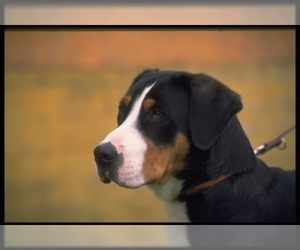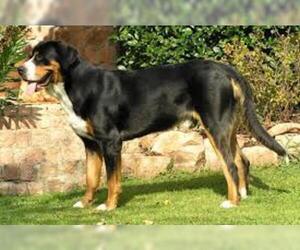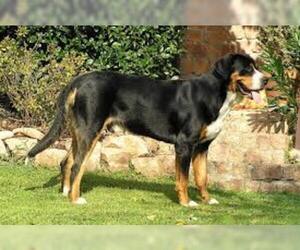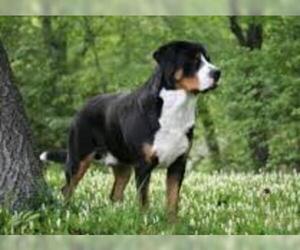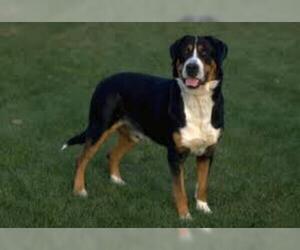
All about Greater Swiss Mountain Dog dog breed
A.K.A. :Swiss Mountain Dog, Greater Swiss, Grosser Schweizer Sennenhund, Grosser Schweizer, GSMD, Swissy, Big Swissy, Giant Swissy, Swiss Cattle Dog, Swiss Draught Dog, Swiss Butcher Dog
Size
Grooming requirements
Exercise requirements
Good with other dogs
Watchdog ability
Energetic
Training requirements
Playful
Affectionate
Good with other pets
Good with children
Good with strangers
Winter
Summer
Healthiness
Protective
Life Span
| Pure Breeds | Member |
| Breeds A - Z | G |
| Breeds by Group | Working |
| Breeds by Trait | Good With Kids High Stamina Dog Breeds |
| Overview: | The Greater Swiss Mountain Dog, or "Swissie," is a magnificent and ancient breed with roots tracing back to the Swiss Alps, where they served as all-purpose farm dogs, herding livestock, guarding property, and pulling carts. Physically, they are large, powerful canines distinguished by their striking tricolored coat—black with rich rust and white markings—and a sturdy, muscular build. Their expression is often described as intelligent and gentle, reflecting their inherent nature. Temperamentally, Swissies are known for being devoted, good-natured, and confident, making them excellent family companions when properly socialized. While adaptable, their size and need for moderate exercise mean they are generally better suited for homes with yards rather than small apartments, though they are calm indoors. They thrive on human companionship and are typically good with children and other pets, displaying a patient demeanor. As with many large breeds, potential owners should be aware of health considerations such as hip and elbow dysplasia, and bloat, requiring responsible breeding and veterinary care. |
F.A.Q.
All You Need to Know About the Greater Swiss Mountain Dog Breed
The Greater Swiss Mountain Dog, or "Swissie," is a magnificent, large breed originating from the Swiss Alps, historically used for herding and drafting. Known for their striking tricolored coat and powerful build, these dogs are also characterized by their calm, confident, and affectionate temperament, making them excellent family dogs. They thrive on companionship and are generally good with children and other pets, though early socialization is crucial. Due to their size and need for space, apartment living isn't ideal; a home with a yard is preferred. Their short coat requires minimal grooming, primarily weekly brushing, but they do shed. Regular, moderate exercise is essential to keep them healthy and prevent boredom. Potential owners should be aware of common health concerns such as hip and elbow dysplasia, and bloat. A Swissie is a loyal, protective, and loving companion for active families.Greater Swiss Mountain Dog Weight: Adult Greater Swiss Mountain Dogs typically weigh between 85-140 pounds. Males are generally heavier, ranging from 105-140 pounds, while females usually fall between 85-110 pounds. This average size represents a healthy weight for Greater Swiss Mountain Dog, ensuring they maintain their sturdy, muscular build.
How Tall is a Greater Swiss Mountain Dog? Understanding Their Average Height
When considering a Greater Swiss Mountain Dog, their impressive size is often a key characteristic. For those wondering about the average height of a Greater Swiss Mountain Dog, these magnificent dogs typically stand quite tall at the shoulder.The typical adult height range for a Greater Swiss Mountain Dog, measured at the highest point of their shoulders (the withers), is:- Males: 25.5 to 28.5 inches (approximately 65-72 cm)
- Females: 23.5 to 27 inches (approximately 60-69 cm)
The Greater Swiss Mountain Dog colors are distinctly tri-colored. The AKC recognized Greater Swiss Mountain Dog colors consist of a black base coat with rich rust (ranging from reddish-brown to mahogany) markings on the cheeks, over the eyes, on the legs, and a distinctive band between the black and white on the sides of the body. White markings are required, typically on the chest (forming a "Swiss cross"), muzzle, tip of the tail, and on the feet. Any departure from this tri-color pattern, such as solid black, solid white, or bi-color, is considered a disqualification by the AKC and other major kennel clubs. There are no rare coat types or exotic Greater Swiss Mountain Dog variations like blue, lilac, merle, chocolate, brindle, fawn, or cream that are officially recognized or accepted in the breed. Such variations would indicate a mix-breed and are not characteristic of a purebred Greater Swiss Mountain Dog. Potential adopters or buyers should be aware that claims of rare Greater Swiss Mountain Dog colors outside the standard tri-color are misleading and do not represent the breed.
Greater Swiss Mountain Dog Personality & TemperamentThe Greater Swiss Mountain Dog personality is characterized by a confident, alert, and amiable disposition. These loyal and devoted companions form strong bonds with their families, often displaying a watchful protectiveness without being overly aggressive. Their temperament of Greater Swiss Mountain Dog is generally friendly and sociable, enjoying interaction with people. They are typically good with children, demonstrating patience and a playful nature, though their large size means supervision is always wise with very young kids. With proper socialization, they can coexist peacefully with other pets, often viewing them as part of their "pack."Greater Swiss Mountain Dogs are intelligent and eager to please, making them relatively easy to train. They are adaptable to various living situations but are not ideal for apartment living due to their size and need for regular exercise. They thrive in homes with ample space, a secure yard, and owners who can provide consistent attention and activity. While generally calm indoors, they possess a playful outdoor energy. Potential owners should be prepared for a dog that thrives on companionship and inclusion in family activities.
Greater Swiss Mountain Dog Temperament & Personality TraitsThe Greater Swiss Mountain Dog (GSMD) is known for its stable, confident, and good-natured temperament, making it a wonderful companion dog. They are generally friendly and sociable with people, often greeting strangers with a calm curiosity rather than immediate suspicion. This breed exhibits immense loyalty and devotion to their families, thriving on close companionship.While not typically suited for apartment living due to their size and need for moderate exercise, a GSMD can adapt if given ample outdoor time and mental stimulation. They are generally excellent with children, possessing a patient and gentle demeanor, though supervision is always recommended with any large breed. Most GSMDs are also good with other pets, especially if socialized from a young age, often living harmoniously with cats and other dogs.Regarding behavior, the Greater Swiss can show a touch of stubbornness, a common trait in many intelligent working breeds. Consistent, positive reinforcement training is key to managing this. They are generally not overly sensitive but do respond best to fair and kind handling, as harsh methods can be counterproductive. Overall, the GSMD is a reliable, affectionate, and protective family member who brings joy and a calm presence to the home.
Greater Swiss Mountain Dog Care: Essential Daily Maintenance & Health TipsGreater Swiss Mountain Dog care involves moderate daily maintenance to ensure a happy, healthy companion. These magnificent dogs are not a low-energy dog breed and require consistent, though not excessive, exercise. Grooming Needs: Their short, dense double coat is relatively low-maintenance, requiring weekly brushing to remove loose hair and minimize shedding. More frequent brushing (2-3 times a week) during shedding seasons is beneficial.Exercise Requirements: Despite their size, they are not high-strung. Aim for 30-60 minutes of moderate daily exercise, such as walks, hikes, or playtime in a securely fenced yard. Avoid strenuous exercise in hot weather due to their brachycephalic (short-nosed) anatomy.Dietary Considerations: A high-quality, large-breed dog food is essential. Monitor portion sizes closely to prevent obesity, a common health concern. Consult your veterinarian for specific dietary recommendations based on age, activity level, and health.Wrinkle and Ear Cleaning: While not heavily wrinkled, check any facial folds for moisture or debris and clean gently with a damp cloth if needed. Their ears should be checked weekly for redness, odor, or wax buildup and cleaned with a vet-approved solution to prevent ear infections.Climate Sensitivity: Due to their brachycephalic anatomy, Greater Swiss Mountain Dogs are sensitive to heat and humidity. Exercise should be limited during hot weather, and they should always have access to shade and fresh water. Air conditioning is crucial during summer months.Common Health Concerns:* Skin issues: Regularly inspect their coat and skin for any signs of irritation, hot spots, or allergies.* Dental care: Daily or frequent teeth brushing is vital to prevent dental disease, which can lead to more serious health problems.* Weight management: As mentioned, these dogs are prone to weight gain. Strict dietary control and consistent exercise are key to preventing obesity and related joint problems. Regular vet check-ups are important for overall health tips for Greater Swiss Mountain Dog.
The Greater Swiss Mountain Dog activity level is moderate, balancing surprising bursts of energy with a preference for long periods of rest. Despite their size, Greater Swiss Mountain Dog exercise needs are not as demanding as some working breeds. They typically enjoy a good daily walk (30-60 minutes) and some playtime in a securely fenced yard. They are generally not suited for intense, prolonged running partners due to their massive build and brachycephalic anatomy, which can make them prone to overheating and breathing difficulties, especially in warm weather. Short, consistent walks and mentally stimulating activities are more appropriate. They love to play, often engaging in playful wrestling or short games of fetch, but will quickly settle down for a nap. How active are Greater Swiss Mountain Dog? They are adaptable; they can enjoy an active outing but are equally content lounging indoors with their family. They are suitable for moderately active families who can provide consistent, gentle exercise, but their lower endurance limits make them less ideal for highly active, endurance-focused households. They are a good fit for families seeking a large, affectionate companion who enjoys both activity and relaxation.
Breed Breakdown: What Experts Say About the Greater Swiss Mountain Dog
I would rate the "Size" trait of the Greater Swiss Mountain Dog an 8 out of 10.They are a genuinely large breed. Males typically stand 25.5 to 28.5 inches tall and weigh 115 to 140 pounds, while females are slightly smaller at 23.5 to 27 inches and 85 to 110 pounds. Their robust, muscular, and sturdy body structure contributes to their substantial presence. When compared to most other companion dogs, even large ones, the Greater Swiss Mountain Dog often appears more massive and heavier-bodied. Their size means they are definitely not best suited for apartment living or households with significant space constraints. While they are generally calm indoors, their sheer physical dimensions require ample room to move comfortably without constantly bumping into things or feeling cramped. Travel can also be challenging due to their size, often requiring a larger vehicle and considerable planning for their comfort and safety. They thrive best in homes with a generous yard and owners who understand and accommodate their need for space.
I'd rate the Greater Swiss Mountain Dog's grooming requirements at a 3.They are a relatively low-maintenance breed when it comes to grooming, especially compared to many other companion dogs. Their short, dense double coat sheds moderately year-round, with heavier seasonal shedding, but it doesn't typically mat or tangle and simply requires a good brushing a few times a week to remove loose hair and dirt. They don't have extensive skin folds that require special attention, nor are they particularly prone to skin issues or allergies that demand frequent medicated baths or specialized care. Ear cleaning is generally only needed on an "as-needed" basis, which for most healthy dogs is infrequent. Nail trimming is a standard requirement for all breeds, and their bathing needs are minimal, typically only when they get visibly dirty or once every few months. While not "extremely low-maintenance" like some very short-haired breeds with almost no shedding, they are far from requiring the frequent, specialized grooming of long-haired, double-coated, or heavily-folded breeds.
I would rate the Greater Swiss Mountain Dog's exercise requirements at a 6 out of 10.While not in the realm of high-octane working breeds, the Greater Swiss Mountain Dog is a large, powerful dog bred for hauling and farm work, and they retain a significant amount of that energy. They are not dogs that thrive with minimal activity. Daily activity recommendations typically include at least 60 minutes of moderate exercise, often broken into two or more sessions. Their energy levels are moderate to high, especially in their younger years, and they enjoy purposeful activity. They have good tolerance for sustained movement, enjoying long walks, hikes, and carting, which aligns with their historical purpose.However, their size and build, while not severely brachycephalic, mean they can be prone to overheating and should not be over-exercised in hot weather. Their respiratory capabilities are generally good, but caution is still warranted. While they can enjoy playtime, they are often more content with structured activities that engage both their body and mind. Agility can be a fun outlet for some, but due to their size and potential for joint issues, it needs to be approached with care and not pushed to extremes. They truly benefit from structured routines that provide both physical exertion and mental stimulation, like obedience training, drafting, or even just consistent, engaging walks. Without adequate exercise and mental engagement, they can become bored and potentially destructive, or conversely, prone to weight gain.
I would rate the Greater Swiss Mountain Dog's "Watchdog Ability" as an 8 out of 10.Swissys are highly alert and possess a natural instinct to protect their home and family. They are known for their deep, resonant bark, which they readily employ to announce the arrival of strangers or to signal anything unusual. While not typically aggressive, their imposing size and confident demeanor are often enough to deter potential intruders. They are keenly aware of their surroundings and will investigate unfamiliar sounds or sights, making them excellent providers of early warnings. They are loyal and protective without being overly suspicious or reactive, striking a good balance between vigilance and being a stable family companion. They are definitely capable of providing meaningful early warnings in a home environment and their presence alone can be a strong deterrent.
I would rate the "Good with Other Dogs" trait of the Greater Swiss Mountain Dog at a 7 out of 10.Greater Swiss Mountain Dogs are generally known for their calm, even temperaments and tend to be quite amiable with other dogs, especially when properly socialized from a young age. They are often described as "gentle giants" and their patient nature usually extends to their interactions with other canines, even those of different sizes and energy levels. They don't typically exhibit high levels of dog-on-dog aggression, and many thrive in multi-dog households, enjoying the companionship.However, a rating of 7, rather than a higher score, acknowledges a few important nuances. Like all large, powerful breeds, a lack of adequate socialization can lead to them being reserved or even wary around unfamiliar dogs, and their size alone can be intimidating or lead to accidental rough play if not taught proper manners. While not inherently dominant, they can be assertive and may test boundaries, especially with unconfident or overly submissive dogs. Careful introductions are always recommended, particularly with intact males or in situations with strong personalities, and consistent training is essential to ensure they remain polite and well-adjusted canine citizens. They generally thrive in canine company, but benefit from thoughtful management and ongoing positive experiences to maintain their sociable nature.
I would rate the Greater Swiss Mountain Dog's "Energetic" trait a 5 out of 10.While not a couch potato, the Greater Swiss Mountain Dog is a moderately energetic breed. They possess a good amount of stamina for their size and enjoy regular, purposeful activity like long walks, hikes, or even pulling a cart. They are playful and enjoy interacting with their families, but they aren't typically "bouncing off the walls" like some herding or terrier breeds. They have a more "working" type of energy – capable of sustained effort when given a task, but also content to relax and be part of the family once their exercise needs are met. Compared to many companion dogs, they are more active than truly sedentary breeds but certainly more laid-back than high-drive working or sporting dogs.Their brachycephalic anatomy is a significant factor in their exercise tolerance. While not as extreme as some other brachycephalic breeds, their shorter snouts can make them more susceptible to overheating and respiratory distress during intense or prolonged exercise, especially in warm weather. This limits their ability to participate in extremely high-impact or endurance-focused athletic activities and means owners must be vigilant about monitoring their breathing and avoiding overexertion. Their endurance is good for moderate activities but is significantly impacted by their respiratory limitations during strenuous efforts.
I would rate the training requirements of the Greater Swiss Mountain Dog at a 6 out of 10.While intelligent and capable of learning, the Greater Swiss Mountain Dog is not a "plug and play" breed when it comes to training. Their intelligence can sometimes be coupled with a noticeable streak of independence and stubbornness, especially during adolescence. They have a relatively good attention span for tasks they find engaging, but can quickly lose interest if training becomes repetitive or dull. They respond well to commands, but consistency is absolutely paramount; any laxity will be quickly exploited. Positive reinforcement, particularly with high-value treats and praise, is highly effective, as harsh methods are counterproductive and can lead to a shut-down dog. They are not entirely beginner-friendly and will benefit greatly from an owner who is patient, consistent, and committed to structured routines and ongoing socialization. While a determined novice can succeed, someone with prior dog training experience will likely find the process smoother and more rewarding.
The Greater Swiss Mountain Dog rates a solid 7 on the Playful scale. While they aren't the boisterous, constantly "on" breed, they possess a delightful and often surprisingly silly playfulness once they're out of their puppy stage and into their more mature, calm demeanor. They absolutely love a good game of fetch, especially with a beloved person, and will enthusiastically engage with squeaky toys, tug ropes, and puzzle feeders. Their larger size means their play can be quite physical, involving enthusiastic leaps and bounds, but they are generally mindful of their strength around their human companions. They thrive on interaction and will often initiate playtime with a nudge, a happy tail wag, or by bringing you a favorite toy. While not overtly attention-seeking in a needy way, they certainly appreciate and enjoy being included in family activities and will often position themselves to observe or participate in whatever is happening. Compared to many high-energy companion dogs, they are more laid-back indoors, happy to snooze at your feet, but they are far from inactive. Their playfulness emerges readily during outdoor adventures, walks, and dedicated play sessions, making them a wonderfully fun and engaging companion for those who appreciate a dog with both a calm side and a joyful zest for life.
I would rate the Affectionate trait of the Greater Swiss Mountain Dog as a 9.Swissies are renowned for their deep devotion to their families and their strong desire for human companionship. They are very people-oriented and thrive on being part of the family unit, often following their loved ones from room to room. While not necessarily "lap dogs" due to their size, they are certainly "leaners" and will happily press themselves against you for physical closeness, enjoying pats and scritches. Their loyalty is unwavering, and they are quite sensitive to the moods and emotions of their owners, often offering a comforting presence. They truly flourish when they receive consistent affection and inclusion in daily life, and while they possess a working dog's independence of thought, their emotional need for their human family is paramount compared to many other companion breeds.
I would rate the Greater Swiss Mountain Dog's "Good with Other Pets" trait a 7 out of 10.Explanation:Greater Swiss Mountain Dogs generally possess a calm and gentle disposition, which extends to their interactions with other animals. They are not typically aggressive and, with proper socialization from a young age, can coexist very peacefully with other dogs and even cats. Their prey drive is relatively low compared to many other breeds, particularly when it comes to smaller household pets, though individual variation always exists.However, a "7" instead of a higher score acknowledges a few important points. While naturally sociable, their size and strength mean that even playful interactions can accidentally overwhelm smaller pets. Resource guarding, while not inherently a strong breed trait, can manifest in any dog, and their protective nature towards their "flock" (which can include human family and other pets) means that careful introductions and ongoing supervision, especially with new or unfamiliar animals, are always recommended. They thrive on clear structure and leadership, and consistent training helps them understand their place in a multi-pet household. They are adaptable, but successful integration relies heavily on the owner's commitment to early and continuous socialization and managing their inherent "big dog" energy around more delicate companions. While generally good-natured, they are not a breed that can simply be thrown into a multi-pet household without thoughtful integration and ongoing guidance.
I would rate the Greater Swiss Mountain Dog's "Good with Children" trait a 9 out of 10.This breed is generally renowned for being exceptionally child-friendly. Their inherent calm and gentle temperament makes them very patient with the often boisterous nature of children. They are typically tolerant of noise and the sometimes clumsy handling that younger kids can dish out, exhibiting a remarkably laid-back demeanor. While they possess a playful side, especially as puppies, they are not overly energetic to the point of being overwhelming for children, preferring a more sedate form of interaction once mature. Their loyalty and protective instincts, when properly socialized, translate into a watchful and caring presence around their family's children. They are naturally affectionate and tend to be quite gentle, though like all large breeds, early socialization and consistent training are crucial to ensure they understand their boundaries and remain well-mannered around children of all ages. Supervision is always recommended with any dog and child, especially younger ones, but the Greater Swiss Mountain Dog's natural inclination is towards being a loving and trustworthy family companion.
I would rate the Greater Swiss Mountain Dog's "Good with Strangers" trait a 7 out of 10. While naturally confident and generally friendly, they are also a loyal guardian breed, meaning they possess an inherent watchfulness. They are not typically aloof or unfriendly, but rather observant. A well-socialized Swissy will usually be welcoming and tolerant of new people in their home or in public, often seeking a polite sniff and a head scratch. However, their natural guarding instinct means they might not immediately jump into a stranger's lap like some more effusive breeds. They are not naturally outgoing to the extent of being indiscriminately friendly with everyone they meet without any prior experience, but rather their friendliness is built on a foundation of confidence and good socialization. Training and early exposure to a variety of people are crucial to ensure their natural wariness doesn't manifest as excessive barking or a more reserved demeanor, solidifying their inherent good nature into consistent, welcoming behavior. They are adaptable in public, but always maintain a degree of awareness of their surroundings.
I would rate the Greater Swiss Mountain Dog's "Winter" tolerance at a 9.The Greater Swiss Mountain Dog possesses excellent cold-weather resilience, largely due to its thick, double coat, which provides significant insulation. Their large, muscular build and substantial body fat further contribute to their ability to retain warmth. While they are a large breed, their brachycephalic anatomy is not severe enough to significantly hinder their ability to breathe in cold air, unlike some other brachycephalic breeds. They are generally robust and can safely enjoy extended outdoor activity in very cold climates without an elevated risk of hypothermia compared to many other dog breeds. Their heritage as a working dog in the Swiss Alps speaks to their natural adaptation to harsh, cold environments. Compared to other companion dogs, the Greater Swiss Mountain Dog typically requires minimal special care during winter months, often thriving in conditions that would necessitate much greater protection for short-haired or smaller breeds. They may even prefer colder temperatures, becoming more active and playful.
The Greater Swiss Mountain Dog, with its large size, thick double coat, and moderately brachycephalic (shorter muzzle) structure, has a "Summer" tolerance rating of 3 out of 10. This breed is highly sensitive to heat and at significant risk for heatstroke. Their thick coat, while excellent for cold weather, traps heat, making it difficult to cool down. The moderately brachycephalic anatomy, though not as extreme as some other flat-faced breeds, still compromises efficient panting, which is their primary method of expelling heat. During hot weather, even moderate exercise can quickly lead to overheating. They absolutely require special care in summer months compared to many other companion dogs, including limited outdoor activity during the hottest parts of the day, access to air-conditioned indoor spaces, and constant access to fresh water. Without these precautions, their health can rapidly deteriorate.
I would rate the Greater Swiss Mountain Dog's "Healthiness" trait as a 7 out of 10.While generally considered a robust and healthy breed compared to many other large companion dogs, they are not without their specific health concerns. Their life expectancy typically ranges from 8 to 11 years, which is respectable for a giant breed. Responsible breeding practices have certainly helped mitigate some issues, but genetic predispositions do exist. Common breed-specific health concerns include bloat (gastric dilatation-volvulus), which is a serious and life-threatening condition for all deep-chested breeds, various orthopedic problems like hip and elbow dysplasia, and osteochondrosis dissecans (OCD). Eye conditions such as entropion and cataracts can also occur. While they don't typically suffer from severe breathing difficulties like some brachycephalic breeds, their large size and activity level require owners to be mindful of heat exhaustion. They are not generally considered high-maintenance in terms of health, but proactive preventive care, including regular veterinary check-ups, appropriate diet, and monitoring for signs of bloat or joint issues, is crucial. Their generally good temperament and sturdy build contribute to a perception of health, but the potential for serious orthopedic and digestive issues prevents a higher rating.
I would rate the Greater Swiss Mountain Dog's "Protective" trait at an 8 out of 10.Explanation:The Greater Swiss Mountain Dog is a naturally watchful and confident breed. They are highly alert to their surroundings, possessing a keen sense of hearing and sight that makes them excellent at detecting unusual activity or approaching strangers. Their territorial instincts are well-developed; they will typically bark to announce visitors and patrol their property. Their loyalty to their owners is unwavering, and they form strong bonds with their families, which fuels their desire to keep them safe.Regarding strangers, they are generally reserved and can be initially wary, observing new people carefully before accepting them. This wariness, combined with their imposing size and deep, resonant bark, acts as a significant deterrent. While they are fundamentally companion dogs and not inherently aggressive, their size, strength, and courageous nature mean they are absolutely capable of offering meaningful protection in a household setting. They will likely intervene if they perceive a genuine threat to their family or home, using their physical presence and a strong, protective stance to deter intruders. They are more than just a bark; they are capable of backing it up, making them excellent watchdogs and effective deterrents against potential threats.
I would rate the "Life Span" trait of the Greater Swiss Mountain Dog at a 5.This rating places the breed in the average category when compared to other companion dogs. While a lifespan of 8-11 years is not exceptionally short, it's also not considered long-lived. They are a large breed, and generally, larger breeds tend to have shorter lifespans than smaller ones. While responsible breeding and care can contribute to a healthier life within this range, they are prone to certain health issues common in giant breeds, such as bloat, elbow and hip dysplasia, and some cancers, which can impact their longevity. Their average lifespan is neither a significant concern nor a standout positive attribute for the breed.
Greater Swiss Mountain Dog Dogs for adoptionSee all dogs for adoption
Greater Swiss Mountain Dog BreedersSee all breeders
Similar Dog Breeds for Greater Swiss Mountain Dog
Breed Mixes of Greater Swiss Mountain Dog
Quick Breed Selector 0 - not important, 1 - smallest, 10 - largest
Variants & Mistakes :Greater Swiss Moutain Dog, Greater Swis Mountain Dog, Greter Swiss Mountain Dog, Grater Swiss Mountain Dog, Greter Swis Mountain Dog, Grater Swis Mountain Dog, Greater Swiz Mountain Dog, Greater Swiss Mountian Dog, Greter Swiss Mountian Dog, Grater Swiss Mountian Dog, Greater Swiss Mt Dog, Greater Swiss Mountaindog, Greter Swiss Mountaindog, Grater Swiss Mountaindog, Greater Swiss Mountindog, Greter Swiss Mountindog, Grater Swiss Mountindog, Greater Swis Mountaindog, Greter Swis Mountaindog, Grater Swis Mountaindog, Greter Swiss Montain Dog, Grater Swiss Montain Dog, Greater Swis Moutain Dog, Greter Swiss Moutain Dog, Grater Swiss Moutain Dog, Greate Swiss Mountain Dog, Greate Swis Mountain Dog, Greatr Swiss Mountain Dog, Greatr Swis Mountain Dog, Greate Swiss Moutain Dog, Greatr Swiss Moutain Dog, Greater Swiss Mountin Dog, Greter Swiss Mountin Dog, Grater Swiss Mountin Dog, Greater Swis Mountin Dog, Greter Swis Mountin Dog, Grater Swis Mountin Dog, Grtr Swiss Mountain Dog, Gtr Swiss Mountain Dog, Swis Mountain Dog, Swiss Mountain Dog, Swis Moutain Dog, Swiss Moutain Dog, Swis Montain Dog, Swiss Montain Dog, Swis Mt Dog, Swiss Mt Dog
